LEXINGTONMASSACHUSETTS |
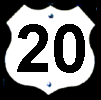 |
LEXINGTONMASSACHUSETTS |
 |
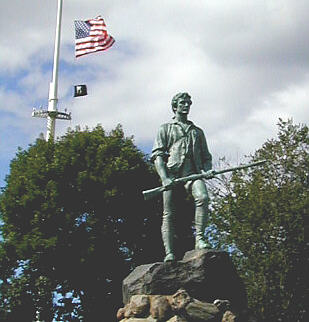 It
was dawn on April 19, 1775 when the British advance troops under Maj. John
Pitcairn arrived from Boston. Capt. John Parker, who was forewarned, had his
militia lined up on Lexington Common. Because he had only 77 men, Parker had no
thought of impeding the 700 British soldiers. He wanted to make a display of
patriot resolve. But as the militiamen slowly obeyed Pitcairn's order to
disperse, a shot was fired-it is not clear from which side-and the green British
soldiers, ignoring orders to stop, began firing at will at the fleeing
Americans. When Pitcairn and Smith regained control, eight Americans lay
dead.
It
was dawn on April 19, 1775 when the British advance troops under Maj. John
Pitcairn arrived from Boston. Capt. John Parker, who was forewarned, had his
militia lined up on Lexington Common. Because he had only 77 men, Parker had no
thought of impeding the 700 British soldiers. He wanted to make a display of
patriot resolve. But as the militiamen slowly obeyed Pitcairn's order to
disperse, a shot was fired-it is not clear from which side-and the green British
soldiers, ignoring orders to stop, began firing at will at the fleeing
Americans. When Pitcairn and Smith regained control, eight Americans lay
dead.
Ralph Waldo Emerson coined the phrase "the shot heard 'round the world" to describe the significance of the skirmishes that took place at Lexington and at North Bridge in Concord.
Although the British fought two small skirmishes at Lexington and Concord, they fought a battle along the road from Concord to Lexington. Some may criticize the tactics used by the patriots in their engagements with the British along the road. However, the tactics they used can be clearly found in any military handbook. When an enemy that has attacked is turned to retreat, defense forces should pursue the retreating enemy. Not to pursue has been a mistake made, even today, by many military commanders. It is often not done because of troop exhaustion or for humanitarian, but the result is often that the retreating enemy is able to recover and fight another day. There is no doubt that the sting of Lexington and Concord was on the minds of the British during their occupation of Boston. They did not launch any further penetrations into the surrounding countryside.
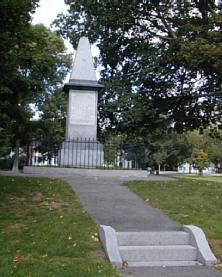
|
Sacred to Liberty of the Rights of Mankind!!! The freedom and independence of America, sealed and defended with the blood of her sons. This monument is erected by the inhabitants of Lexington, under the patronage and at the expense of the Commonwealth of Massachusetts. To the memory of their fellow citizens, Ensign Robert Munroe, Jonas Parker, Samuel Hadley, Jonathan Harrington Jr., Isaac Mazzy, Caleb Harrington and John Brown of Lexington and Asah Porter of Woburn who fell on this field, the first victims to the sword of British tyranny and oppression. On the morning of the ever memorable 19th of April, 1775, the die was cast!!! The blood of the martyrs, in the cause of God and their country, was the cement of the Union of these States, the Colonies and gave the spring to the spirit, firmness and resolution of their fellow citizens. They rose as one man, to revenge their brethren’s blood and at the point of the sword, to assert and defend their native rights. They nobly dared to be free!! The contest was long, bloody and affecting. Righteous heaven approved the solemn appeal: victory crowned their arms and the peace, liberty and independence of the United Sates of America was their glorious reward. Built in the year 1799. (Lexington Memorial) |
After the retreat from Concord, the British arrived in Lexington about 2:30 p.m. They were exhausted and close to panic, but there were no hostilities. Instead, they received a much friendlier greeting from Lord Percy and a thousand British reinforcements.
Today, the Lexington Battle Green is surrounded by historic markers and historic homes. A walk around the green, as well as a stop at the Visitor Center, is recommended.
Hancock-Clarke House -
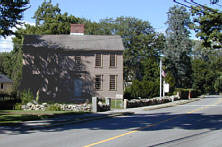 |
Hancock-Clarke House In 1698, this house belonged to the village parson, Rev. John Hancock. He and a grandson-in-law, Jonas Clarke, were ministers here for a total of 107 years. On the night of April 18, 1775, Clarke’s cousin, John Hancock, and Sam Adams, who had been staying here while attending meetings of the Provincial Congress in Concord, were warned by Paul Revere of the advancing British search party. In 1896, another owner planned to tear down the parsonage to improve the view. The Historical Society bought the house for $150 and moved it across the street. Nearly 80 years later, it was returned to the original site. (Lexington Marker) |
Arlington - On April 19, 1775, the worst fighting occurred on the road into this area, where over 5,000 men were involved and both sides lost more men than in any other fighting along the road. After Arlington, Percy had to use cannon several times to scatter the Americans concentrated at his rear. That was probably the edge that allowed him to make it across Charlestown Neck after nightfall to the safety of Bunker Hill, where he was protected by the guns of HMS Somerset in Boston Harbor.
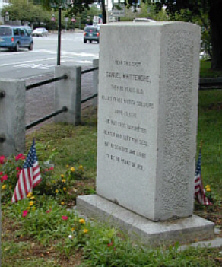 |
Near this spot, Samuel Whittemore, then 80 years old, killed three British soldiers, April 19, 1775. He was shot, bayoneted, beaten and left for dead, but recovered and lived to be 90 years of age. (Arlington Marker) |
On the evening of April 19, 1775, Percy had reached Bunker Hill, but he had lost 73 dead and 174 wounded, with 26 missing. The American losses were 49 dead, 40 wounded, and 5 missing.
Soon after, Boston was under siege and Gage was reduced from
governor to the commander of forces occupying one city. The performance of the
militia that day convinced Percy that this rebellion ran deeper than he or the
ministry had suspected. 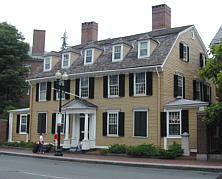 The Americans were indeed prepared to fight for their
rights.
The Americans were indeed prepared to fight for their
rights.
Cambridge - the home of Harvard University
(known as Harvard College in Colonial times). General George Washington arrived
in Cambridge on July 2, 1775 to take command of the Colonial army. Harvard was
occupied by his forces during the British occupation of Boston. The Wadsworth
house, at the edge of campus, was his headquarters.
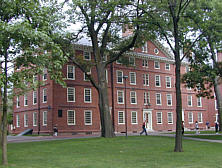 |
Hollis Hall Built by the Province of Massachusetts Bay in New England in 1763. Named in honor of Thomas Hollis of London, Merchant, and other members of the same family, constant and generous benefactors of Harvard College from 1719 to 1804. Used as barracks by Colonial troops in 1775-76. (Harvard University Marker) |
